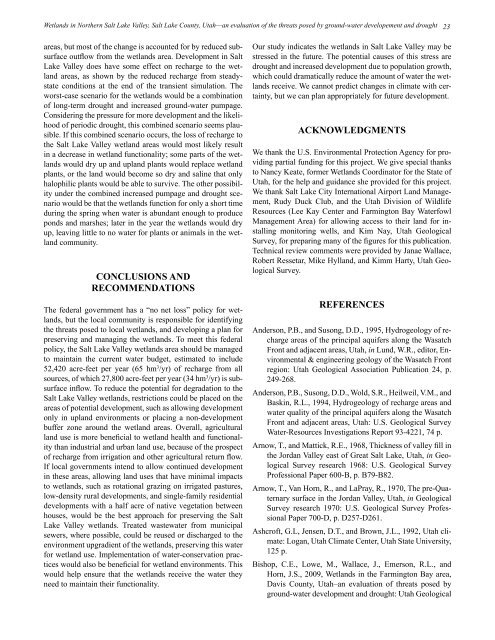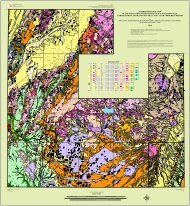Wetlands in northern Salt Lake Valley, Salt Lake County, Utah
Wetlands in northern Salt Lake Valley, Salt Lake County, Utah
Wetlands in northern Salt Lake Valley, Salt Lake County, Utah
Create successful ePaper yourself
Turn your PDF publications into a flip-book with our unique Google optimized e-Paper software.
<strong>Wetlands</strong> <strong>in</strong> Northern <strong>Salt</strong> <strong>Lake</strong> <strong>Valley</strong>, <strong>Salt</strong> <strong>Lake</strong> <strong>County</strong>, <strong>Utah</strong>—an evaluation of the threats posed by ground-water developement and drought 23areas, but most of the change is accounted for by reduced subsurfaceoutflow from the wetlands area. Development <strong>in</strong> <strong>Salt</strong><strong>Lake</strong> <strong>Valley</strong> does have some effect on recharge to the wetlandareas, as shown by the reduced recharge from steadystateconditions at the end of the transient simulation. Theworst-case scenario for the wetlands would be a comb<strong>in</strong>ationof long-term drought and <strong>in</strong>creased ground-water pumpage.Consider<strong>in</strong>g the pressure for more development and the likelihoodof periodic drought, this comb<strong>in</strong>ed scenario seems plausible.If this comb<strong>in</strong>ed scenario occurs, the loss of recharge tothe <strong>Salt</strong> <strong>Lake</strong> <strong>Valley</strong> wetland areas would most likely result<strong>in</strong> a decrease <strong>in</strong> wetland functionality; some parts of the wetlandswould dry up and upland plants would replace wetlandplants, or the land would become so dry and sal<strong>in</strong>e that onlyhalophilic plants would be able to survive. The other possibilityunder the comb<strong>in</strong>ed <strong>in</strong>creased pumpage and drought scenariowould be that the wetlands function for only a short timedur<strong>in</strong>g the spr<strong>in</strong>g when water is abundant enough to produceponds and marshes; later <strong>in</strong> the year the wetlands would dryup, leav<strong>in</strong>g little to no water for plants or animals <strong>in</strong> the wetlandcommunity.CONCLUSIONS ANDRECOMMENDATIONSThe federal government has a “no net loss” policy for wetlands,but the local community is responsible for identify<strong>in</strong>gthe threats posed to local wetlands, and develop<strong>in</strong>g a plan forpreserv<strong>in</strong>g and manag<strong>in</strong>g the wetlands. To meet this federalpolicy, the <strong>Salt</strong> <strong>Lake</strong> <strong>Valley</strong> wetlands area should be managedto ma<strong>in</strong>ta<strong>in</strong> the current water budget, estimated to <strong>in</strong>clude52,420 acre-feet per year (65 hm 3 /yr) of recharge from allsources, of which 27,800 acre-feet per year (34 hm 3 /yr) is subsurface<strong>in</strong>flow. To reduce the potential for degradation to the<strong>Salt</strong> <strong>Lake</strong> <strong>Valley</strong> wetlands, restrictions could be placed on theareas of potential development, such as allow<strong>in</strong>g developmentonly <strong>in</strong> upland environments or plac<strong>in</strong>g a non-developmentbuffer zone around the wetland areas. Overall, agriculturalland use is more beneficial to wetland health and functionalitythan <strong>in</strong>dustrial and urban land use, because of the prospectof recharge from irrigation and other agricultural return flow.If local governments <strong>in</strong>tend to allow cont<strong>in</strong>ued development<strong>in</strong> these areas, allow<strong>in</strong>g land uses that have m<strong>in</strong>imal impactsto wetlands, such as rotational graz<strong>in</strong>g on irrigated pastures,low-density rural developments, and s<strong>in</strong>gle-family residentialdevelopments with a half acre of native vegetation betweenhouses, would be the best approach for preserv<strong>in</strong>g the <strong>Salt</strong><strong>Lake</strong> <strong>Valley</strong> wetlands. Treated wastewater from municipalsewers, where possible, could be reused or discharged to theenvironment upgradient of the wetlands, preserv<strong>in</strong>g this waterfor wetland use. Implementation of water-conservation practiceswould also be beneficial for wetland environments. Thiswould help ensure that the wetlands receive the water theyneed to ma<strong>in</strong>ta<strong>in</strong> their functionality.Our study <strong>in</strong>dicates the wetlands <strong>in</strong> <strong>Salt</strong> <strong>Lake</strong> <strong>Valley</strong> may bestressed <strong>in</strong> the future. The potential causes of this stress aredrought and <strong>in</strong>creased development due to population growth,which could dramatically reduce the amount of water the wetlandsreceive. We cannot predict changes <strong>in</strong> climate with certa<strong>in</strong>ty,but we can plan appropriately for future development.ACKNOWLEDGMENTSWe thank the U.S. Environmental Protection Agency for provid<strong>in</strong>gpartial fund<strong>in</strong>g for this project. We give special thanksto Nancy Keate, former <strong>Wetlands</strong> Coord<strong>in</strong>ator for the State of<strong>Utah</strong>, for the help and guidance she provided for this project.We thank <strong>Salt</strong> <strong>Lake</strong> City International Airport Land Management,Rudy Duck Club, and the <strong>Utah</strong> Division of WildlifeResources (Lee Kay Center and Farm<strong>in</strong>gton Bay WaterfowlManagement Area) for allow<strong>in</strong>g access to their land for <strong>in</strong>stall<strong>in</strong>gmonitor<strong>in</strong>g wells, and Kim Nay, <strong>Utah</strong> GeologicalSurvey, for prepar<strong>in</strong>g many of the figures for this publication.Technical review comments were provided by Janae Wallace,Robert Ressetar, Mike Hylland, and Kimm Harty, <strong>Utah</strong> GeologicalSurvey.REFERENCESAnderson, P.B., and Susong, D.D., 1995, Hydrogeology of rechargeareas of the pr<strong>in</strong>cipal aquifers along the WasatchFront and adjacent areas, <strong>Utah</strong>, <strong>in</strong> Lund, W.R., editor, Environmental& eng<strong>in</strong>eer<strong>in</strong>g geology of the Wasatch Frontregion: <strong>Utah</strong> Geological Association Publication 24, p.249-268.Anderson, P.B., Susong, D.D., Wold, S.R., Heilweil, V.M., andBask<strong>in</strong>, R.L., 1994, Hydrogeology of recharge areas andwater quality of the pr<strong>in</strong>cipal aquifers along the WasatchFront and adjacent areas, <strong>Utah</strong>: U.S. Geological SurveyWater-Resources Investigations Report 93-4221, 74 p.Arnow, T., and Mattick, R.E., 1968, Thickness of valley fill <strong>in</strong>the Jordan <strong>Valley</strong> east of Great <strong>Salt</strong> <strong>Lake</strong>, <strong>Utah</strong>, <strong>in</strong> GeologicalSurvey research 1968: U.S. Geological SurveyProfessional Paper 600-B, p. B79-B82.Arnow, T., Van Horn, R., and LaPray, R., 1970, The pre-Quaternarysurface <strong>in</strong> the Jordan <strong>Valley</strong>, <strong>Utah</strong>, <strong>in</strong> GeologicalSurvey research 1970: U.S. Geological Survey ProfessionalPaper 700-D, p. D257-D261.Ashcroft, G.L, Jensen, D.T., and Brown, J.L., 1992, <strong>Utah</strong> climate:Logan, <strong>Utah</strong> Climate Center, <strong>Utah</strong> State University,125 p.Bishop, C.E., Lowe, M., Wallace, J., Emerson, R.L., andHorn, J.S., 2009, <strong>Wetlands</strong> <strong>in</strong> the Farm<strong>in</strong>gton Bay area,Davis <strong>County</strong>, <strong>Utah</strong>–an evaluation of threats posed byground-water development and drought: <strong>Utah</strong> Geological
















